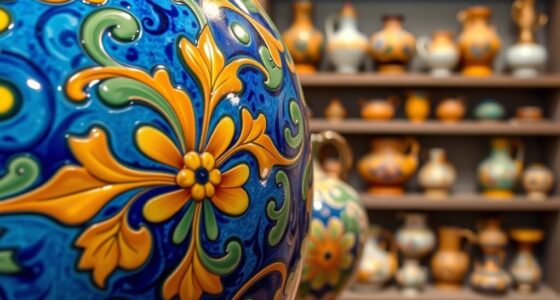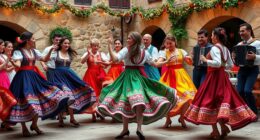Dante, Petrarch, and Boccaccio are Italy’s most influential literary giants, shaping Western literature through their groundbreaking works. Dante’s allegorical *Divine Comedy* revolutionized medieval poetry, while Petrarch’s introspective sonnets marked a shift toward Renaissance humanism. Boccaccio’s lively *Decameron* celebrated human passions and storytelling. Their legacy endures, influencing countless writers and transforming how we explore the human condition. If you continue, you’ll discover how their innovations still inspire storytelling today.
Key Takeaways
- Dante’s *Divine Comedy* established epic allegorical storytelling and moral symbolism in Western literature.
- Petrarch pioneered Renaissance humanism through emotionally expressive sonnets and classical learning.
- Boccaccio’s *Decameron* revolutionized prose with realistic storytelling and exploration of human passions.
- Their works mark the transition from medieval allegorical poetry to Renaissance human-centered narratives.
- These literary giants profoundly influenced Western storytelling, inspiring future writers and shaping literary tradition.

Italy has produced some of the most influential writers in world literature, whose works have shaped cultural and literary traditions across centuries. When you explore Italian literary giants like Dante, Petrarch, and Boccaccio, you see how their contributions span from medieval poetry to Renaissance prose, laying a foundation for Western literary development. You might start by immersing yourself in Dante’s *Divine Comedy*, which exemplifies medieval poetry’s grandeur. His vivid imagery and allegorical storytelling transport you through Hell, Purgatory, and Paradise, reflecting the religious and philosophical concerns of his time. Dante’s mastery of terza rima and his ability to intertwine theological doctrine with personal and political insights demonstrate how medieval poetry was not merely poetic but also a complex reflection of society’s moral and spiritual struggles. These works also exemplify allegorical storytelling, a key feature of medieval literature that uses symbolic figures and narratives to convey moral and spiritual lessons.
Italy’s literary giants like Dante, Petrarch, and Boccaccio shaped centuries of Western storytelling through poetic and prose masterpieces.
As you move into the Renaissance era, you’ll notice Petrarch’s influence in shaping the shift from medieval poetry to Renaissance prose. Petrarch’s sonnets, filled with emotional depth and personal reflection, revolutionized lyrical poetry. His focus on individual experience and love’s complexities mark a departure from the more collective themes of medieval poetry. But Petrarch’s significance extends beyond poetry; his prose essays and letters embody the Renaissance humanist ideals of returning to classical sources and emphasizing individual thought. You’ll see how his work bridges medieval poetic traditions with Renaissance humanism, encouraging a new focus on personal introspection and classical learning.
Boccaccio, meanwhile, pushes this evolution further through his prose works, most famously *The Decameron*. His storytelling style, lively and realistic, introduces a new narrative form that captures everyday life and human passions with honesty and humor. Boccaccio’s writing reflects a Renaissance confidence in human agency and the richness of worldly experience, contrasting with the religious and moral themes of medieval poetry. You’ll appreciate how his prose embodies the Renaissance spirit—celebrating human nature, social dynamics, and individual stories—while still drawing on the poetic traditions of earlier centuries.
Together, these writers demonstrate Italy’s literary progression, from the structured, allegorical poetry of the Middle Ages to the human-centered, expressive prose of the Renaissance. Their works continue to influence writers today, inspiring a deeper understanding of the human condition. Whether you’re reading Dante’s allegories, Petrarch’s introspective sonnets, or Boccaccio’s vibrant stories, you’re engaging with a legacy that transformed literature and remains essential across centuries. Their enduring contributions reveal how Italy’s literary giants shaped not only their own time but also the future of storytelling worldwide.
Frequently Asked Questions
How Did Dante Influence Modern Italian Language Development?
Dante heavily influenced modern Italian language development through his use of the Tuscan dialect, which became a standard for literary innovation. His work, especially the Divine Comedy, shaped linguistic evolution by popularizing a vernacular style that many followed. You can see his impact today as his language forms the foundation of modern Italian, blending literary creativity with everyday speech, making it more accessible and standardized across Italy.
What Themes Unify Petrarch’s Sonnets Across His Lifetime?
Imagine reading Petrarch’s sonnets and sensing a deep connection; you’d notice themes of love and mortality that stay consistent throughout his life. His poetry unifies these themes through poetic innovation and spiritual reflection, revealing his evolving understanding of love’s power and human fragility. You see his desire for idealized love, yet he also contemplates mortality, making his sonnets a timeless exploration of both passionate longing and the transient nature of life.
Which of Boccaccio’s Works Most Impacted European Literature?
You’ll find Boccaccio’s “Decameron” most impactful on European literature, thanks to Medici patronage and his literary innovation. This collection of stories introduced new narrative techniques, humor, and realism, influencing later writers across Europe. By blending everyday life with clever storytelling, Boccaccio set a foundation for modern prose and storytelling, making his work a cornerstone that shaped European literary traditions for centuries.
How Did These Authors’ Personal Lives Shape Their Writings?
Personal struggles and cultural influences profoundly shape these authors’ writings. You see, Dante’s exile fueled his fiery passion for justice and spirituality, while Petrarch’s love life inspired his poetic pursuits. Boccaccio’s experiences with plague and social change fueled his vibrant storytelling. These personal pains and societal shifts influence their themes, tone, and tone, creating timeless works that echo their emotions and environments, ultimately shaping European literature’s evolution.
What Are Lesser-Known Facts About Their Writing Processes?
You might find it fascinating that Dante, Petrarch, and Boccaccio’s writing processes involved meticulous manuscript preservation, often copying texts by hand to ensure accuracy. They drew creative inspiration from personal experiences and classical sources, blending them into their works. Remarkably, Boccaccio’s drafts of “The Decameron” reveal extensive revisions, showing how they refined ideas over time. Their dedication to preserving and perfecting manuscripts fueled their enduring literary legacies.
Conclusion
You see how Dante, Petrarch, and Boccaccio shaped Italian literature, how they inspired writers and readers alike. Their legacy lives on in their stories, in their poetry, in their influence. Their voices echo through time, their ideas resonate through centuries, their creativity sparks new generations. Recognize how their enduring impact, their timeless contributions, their revolutionary spirit continue to inspire us today, reminding us that great literature is forever, and greatness is never forgotten.









